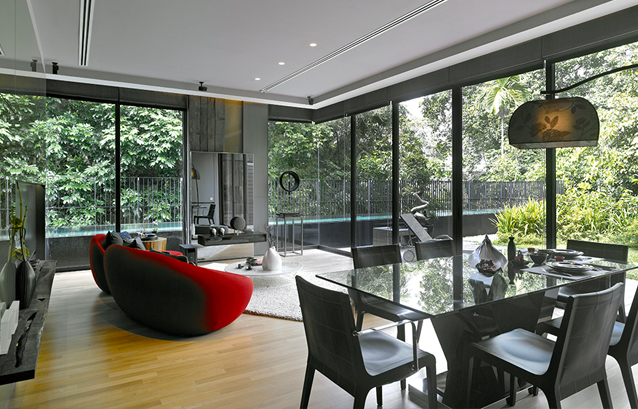From its birth, the Mont Timah project sought to bring something new to the city-state’s residential panorama; in the words of architect Chan Sau Yan of CSYA Associates, “The intent… was to create an alternative typology in landed housing which distinguishes from the traditional bungalow, semi-detached and detached developments – a first of its kind in Singapore.”

To achieve this, the firm arranged unites in clusters of four, arranged as a square block divided into quarters or “quads”. This allows each unit to include the ‘landed’ characteristics of bungalows, with their individual enclosed space on the ground floor inclusive of a water feature, lawn and timber deck. Every quad also enjoys an open corner and a compact plan, enabling generous daylight penetration and views out.

Circulation is concentrated in the centre of each cluster to maximise peripheral floor space. “This forms a structural lift core, from which party walls extend outwards” explains “Each unit is then duplicated four times in rotation around this core, giving rise to a pinwheel plan.”

First and second floor

Third floor and roof
Beyond their architectural innovation, the appeal of the units owes much to their superb natural context. Situated next to the Bukit Timah Nature Reserve, the project revels in exclusive views of dense forest. The compound was contoured as a series of terraces gently cascading from the entrance down to the farthest south-western end to create an unobstructed central vista, capitalising on the site’s original sloping topography.

The structures themselves are characterized by a restrained material palette comprising off-form concrete with pinewood board grain details in natural and charcoal grey stain, Brazilian teak for the interior spaces and Composite timber for exterior decking, Silver travertine for bathrooms, granite/granolithic finishes for exterior spaces and aluminium for all doors and windows, with canopies made of powder-coated dark bronze. The spare concrete cladding is softened by abundant vegetation throughout the site, including an extended vertical green wall.

Overall the development demonstrates an intelligent fusion of the best aspects of bungalow and cluster housing, combining seclusion and private outdoor space with spatial efficiency and consolidated amenities.
For a more in-depth review of the Mount Timah project, pick up a copy of Habitus 19, available March 27.
Photography: Aaron Pocock

